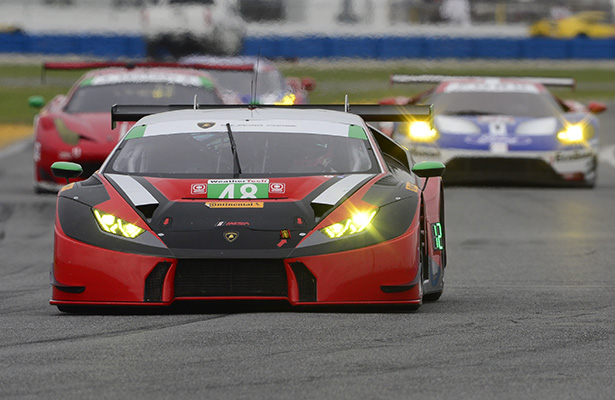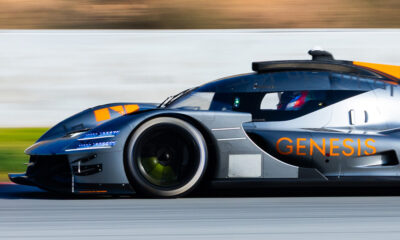
Photo: IMSA
As new regulations debut in the GT Le Mans and GT Daytona classes this weekend at Daytona, so too does a new Balance of Performance process, with IMSA implementing additional data-based measures aimed at closing the performance gap.
IMSA has rolled out with a new proprietary scrutineering data logger system — mandatory on all GTLM and GTD cars — that measures various things such as RPM, throttle position and airbox pressure.
Along with a newly implemented in-session scrutineering checks, the sanctioning body now has a significant amount of new data to work from in determining BoP, according to WeatherTech SportsCar Championship Senior Series Manager Geoff Carter.
“We were able to take the timing and scoring data, the vehicle data and the car configuration at that time, melt all that together and we have a much more clearer picture of what the car’s actually doing,” Carter told Sportscar365.
“Instead of going from a one-dimensional analysis, we’ve almost got this three-dimensional method now by adding two other elements.”
Previously, IMSA had primarily utilized timing and scoring data to determine BoP, but an overhaul has been made by its technical team heading into the 2016 WeatherTech Championship season.
Carter said the new Bosch logger systems — which costs $18,000 per car to outfit — mirrors the FIA’s recently introduced system that is being used for the same purpose.
“What that allows for us is to collect the car data in a pure, standalone form, so the channels have not been altered or modified,” Carter said.
“Not only do we know how it goes from A to B. We know the vehicle dynamics data of what it was doing from A to B.”
The second at-track component is the introduction of “spot checks” during sessions, which sees cars ordered to IMSA’s scrutineering bay to verify a car’s configuration.
A similar procedure, which generally takes 3 to 4 minutes, has been utilized in the FIA World Endurance Championship, most notably at the Le Mans Test Day.
“We pulled the cars straight off the track, ran them through the tech process, pulled some critical elements, such as wing angles, weight and ride height and did an updated [data] dump at that time,” Carter said.
Manufacturers have praised IMSA’s added BoP data measures, particularly after a season that saw one of the largest gaps in performance among the GTLM class cars in recent years.
“The key to this whole thing is IMSA recognizing that they can do better… and they have,” Corvette Racing Program Manager Doug Fehan told Sportscar365.
“When you recognize where your soft spots are, that’s the first step in getting them fixed. We’ve got that recognition from them and their expressed willingness to improve.”
IMSA also took all GTLM and GTD class cars to the wind tunnel late last year to determine the aerodynamic characteristic of each model. Carter said that data was used to determine the initial 2016 BoP.
“We had a great Windshear wind tunnel test with all the manufacturers,” Fehan added. “It was a very, very, very productive test. It’s the starting point.
“Balance of Performance will never be perfect but we know it can be a lot better.”
Defending GTLM class champions Porsche have also been in favor of the more data-based system, despite the added costs to outfit the cars with the data logger units.
“Like I said last year, the sport can’t survive if BoP isn’t working,” Marco Ujhasi, Overall Project Leader for Porsche GT Works Motorsport told Sportscar365.
“If you look at the different car concepts here, from one extreme of the Ford to the other with the BMW, it’s not easy to balance this.
“Therefore, if you want to have these cars running in the same class and the same competition, you must look at the performance windows and the reference engine curves.
“If it’s really working, then I’m quite confident that it will go in the right direction and it would stop some day, hopefully.
“One thing’s clear, you need the BoP if you want to run such different cars. It’s essential for GT racing.”
Carter said some of their first findings were quite revealing, with IMSA’s data from the Roar Before the 24 showing that every single car, for a lack of a better word — sandbagged — during the three-day test.
“Ultimately, what we found across the board was an element of underperformance that was pervasive,” Carter said.
“We simply took the top-five fastest laps of every car and we were able to identify in every single one of those laps, in every single car — all 54 of them — an area of underperformance. In every single one of them.”
The data was presented to manufacturers during video conference calls, with whitewashed graphics in order to prevent the identification of the offenders.
Carter said: “What we did was put up the [slides with anonymous data] and said, ‘Guys, here’s what we saw and you’re all guilty of it.’
“We did it in a group setting, with everyone on the call, and allowed all of the manufacturers to comment on what they had just seen.
“In the end, we took an extra day to understand it and got some additional feedback and by Thursday mid-day, we published the [pre-Rolex 24] BoP.”
While currently being used in the two GT categories, Carter said they will implement the same data loggers on the Prototype class next year, when the new P2/DPi formula debuts.
The ultimate test will come this weekend, to see how close IMSA has come with its new data points. So far, Carter has been pleased by the response from the manufacturers.
“The manufacturers have been asking for structure in their own way and have been very responsive to the changes IMSA has made,” he said.
“We’re all very encouraged from IMSA’s side and from the manufacturers’ side that things are going in the right direction.”

























